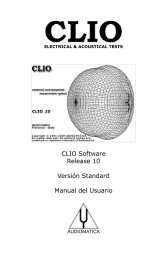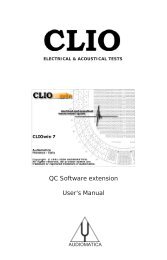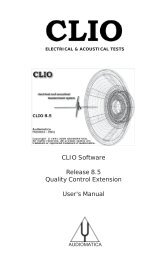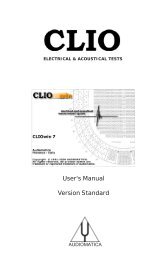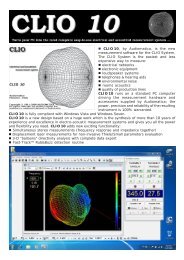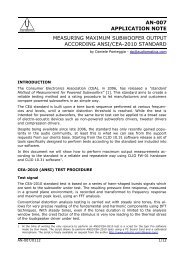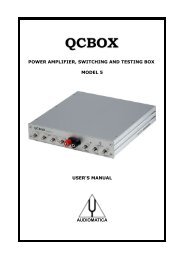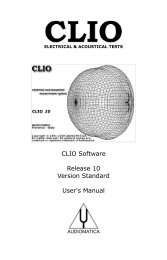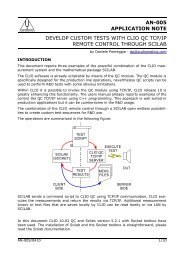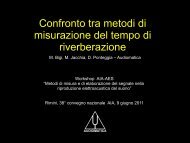CLIOwin 6.5 PCI User's Manual - Audiomatica Srl
CLIOwin 6.5 PCI User's Manual - Audiomatica Srl
CLIOwin 6.5 PCI User's Manual - Audiomatica Srl
You also want an ePaper? Increase the reach of your titles
YUMPU automatically turns print PDFs into web optimized ePapers that Google loves.
10.4 MEASURING FREQUENCY RESPONSE<br />
In a step by step process we will deal with any single aspect that affects MLS<br />
measurements results. At first we deal with electrical measurements, leaving acoustical<br />
as the last steps.<br />
10.4.1 MEASUREMENT LEVEL<br />
Opening the MLS menu for the first time you will see a graph which has frequency on<br />
its X-axis. Despite the mother of all information is in the time domain here, this<br />
approach, in our opinion, greatly simplifies a step by step approach. In fact user can<br />
at first completely ignore most of the settings we encountered in the previous<br />
paragraphs and get the most intuitive piece of information, that is the Frequency<br />
Response of a device under test. Our first step will be measuring the response of an "A"<br />
weighting filter. All the settings are left in their default state; we will take care on<br />
measuring level only. Ours is not a power device, is not a loudspeaker, so we think it<br />
cannot be damaged with an output set to 0dB (-5.21dBV with Mls signals). We connect<br />
CLIO output A with the device input, CLIO Input A with the device output, we enable<br />
input auto-range and click the Go button. As result we get Fig.10.5<br />
30.0<br />
CLIO<br />
180.0<br />
40.0<br />
CLIO<br />
180.0<br />
dBV<br />
Deg<br />
dBV<br />
Deg<br />
20.0 108.0<br />
30.0 108.0<br />
10.0 36.0<br />
20.0 36.0<br />
0.0 -36.0<br />
10.0 -36.0<br />
-10.0 -108.0<br />
0.0 -108.0<br />
-20.0 -180.0<br />
20 Hz<br />
100 1k 10k 20k<br />
Figure 10.5 and 10.6<br />
-10.0 -180.0<br />
20 Hz<br />
100 1k 10k 20k<br />
The curve reaches 16dBV (6.3V) at 2.5kHz, which is a quite high level for our device.<br />
Looking for trouble, we increase CLIO output to +6dB and measure again obtaining<br />
Fig.10.6. The device went into saturation; in more emphatic terms it is not linear any<br />
more. The whole MLS process works on the assumption the device is linear. If this is<br />
not the case, is not easy for inexperienced user to understand what is going on just by<br />
inspecting the results. Checking the measuring level is important, especially when the<br />
gain of the device under test is unknown. You should use the Multi-Meter and the MLS<br />
signal to accomplish this.<br />
10.4.2 MLS SIZE<br />
The Mls Size is the number of points that defines the MLS sequence. In terms of<br />
generating a digital signal these are the numbers of samples before the signals is started<br />
again from the beginning. CLIO handles MLS sizes from 4k to 128k. These terms are<br />
inherited by the computer world and are somehow imprecise. The real size is the nearest<br />
power of 2, the 4k being 4096 points and the 128k 131072 points long (one less!). The<br />
first important consequence of setting the Mls size is the length of the Impulse Response<br />
recovered which is always as long as the Mls itself. From the user point of view what<br />
matters is how long this impulse is in terms of seconds. This in turns depends also on<br />
the Sampling Frequency set. It is easily calculated as the size divided by the sampling<br />
frequency. The default is 16k and 51200Hz, that is 16384/51200=0.32 seconds. We will<br />
90 Chapter 10 - MLS




